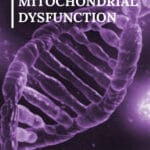Mitochondrial damage is the result of dietary choices, lifestyle habits, stress, and environmental exposures. Fortunately, there are things we can do to improve mitochondrial function.

Mitochondrial dysfunction leads to not only fatigue but to pain and many other fibromyalgia symptoms as well. In fact, just about every single symptom of fibromyalgia can be explained by mitochondrial dysfunction.
Every cell in our body contains mitochondria. It is the mitochondria that determine how much energy we have available on a daily basis. Energy is essential to keep the body functioning properly.
Just staying alive consumes about two-thirds of all energy production. Many of us with chronic illness do not even have enough energy to keep our body functioning properly so there is none to spare for physical and mental activity.
Dietary choices, lifestyle habits, stress, and environmental exposures all contribute to mitochondrial damage. So these are the things we have to address.
Change Your Diet To Improve Mitochondrial Function
The Standard American Diet is high in saturated fat, processed meats, refined grains, sweets, and high-fat dairy which can damage mitochondria over time. We simply don’t get enough nutrients and antioxidants from our food.
Dr. Sarah Myhill, author of Sustainable Medicine recommends the Stone Age diet also known as the Paleo Diet. She believes that whatever our medical problem may be, or even if we simply want to stay well, we should all move towards eating a Stone Age diet.
The Stone Age diet avoids common allergens and is as free from chemicals as possible. The diet is based on protein (meat, fish, eggs), fats, and vegetable fiber. By eliminating grains, dairy,
Supplements That Support Mitochondrial Function
There is a variety of vitamins and supplements that have been used to treat mitochondrial dysfunction. The problem is the variety and dosage depend on the individual.
Some supplements that are known to boost and protect the mitochondria include:
- Alpha lipoic acid – This potent antioxidant is essential for mitochondrial function. In addition to cellular energy production, it helps block inflammatory signals. Lipoic acid comes in two forms labeled “R” and “S.” Pure R-lipoic acid provides twice the active ingredient as a typical R/S-alpha lipoic acid supplement. ***Alpha-lipoic acid can decrease blood sugar levels and interfere with diabetes, thyroid, and cancer medications.
- Coenzyme Q10 – CoQ10 is an important vitamin-like substance. It is produced by the mitochondria inside your cells and is a key enzyme for producing energy. CoQ10 also neutralizes toxic substances and waste products that may damage your cells, potentially producing pain. CoQ10 deficiency has been implicated in fibromyalgia. Researchers who studied the link between mitochondrial dysfunction, oxidative stress and inflammation in fibromyalgia concluded that CoQ10 has a potential therapeutic role in the condition. In one study, supplementation with 300 mg of coenzyme Q10 a day was found to be associated with clinical improvements, including a significant reduction in pain, fatigue, and morning tiredness. ***Coenzyme Q10 can interfere with the actions of some blood-thinning medications.
- L-Carnitine – L-carnitine helps protect and revitalize the mitochondria. It is one of several forms of carnitine at work in your body. Carnitines carry certain fatty acids to mitochondria to be burned as fuel. They also carry away the waste products of this process. L-carnitine is important for heart and brain function, muscle movement, and many other body processes. ***Do not take L-carnitine if you are pregnant or breastfeeding, have had seizures or have thyroid problems. It may interact with some medications such as Acenocoumarol (Sintrom) and Warfarin (Coumadin).
- D-ribose – Ribose is a sugar used by the body to help mitochondria produce ATP, mostly in our muscle cells. Extended periods of stress on the body can cause a chronic depletion of D-ribose. D-ribose supplementation has been used for heart patients since 2003. In fibromyalgia, a major cause of concern is energy starvation in muscle tissue. Our muscles consume energy more quickly than it can be restored. Ribose is required to restore this lost energy and put the ratio of energy supply and demand back in balance. The recommended dosage is 5 grams (1 teaspoon) two to three times a day with a meal. It generally takes no more than a few days to feel the effect of d-ribose supplementation. ***Diabetics should take to their doctor first, especially if you are insulin-dependant.
- Magnesium – Magnesium is crucial for mitochondrial health and energy generation. In addition to its effects on mitochondria, magnesium is essential to relax muscles and nerves. Magnesium deficiency affects not only people with fibromyalgia, but it also affects over 70 percent of the population, in general. Many pharmaceutical drugs drive magnesium levels even lower. There are many different types of magnesium supplements. Magnesium Malate has been studied for use in fibromyalgia. It can help improve ATP production since malate is necessary for the cellular energy cycle.
- Vitamin B & Vitamin C – Coenzyme Q10 is dependent on vitamins B1 (thiamin), vitamin B2 (riboflavin), vitamin B3 (niacin), vitamin B5 (pantothenic acid), vitamin B6 (pyridoxine), vitamin B7 (biotin), vitamin B9 (folic acid), vitamin B12 (cobalamin), and vitamin C in mitochondrial respiration and energy production.
There are more minerals, vitamins, and supplements that affect mitochondrial function, but this is a decent list to consider.
Exercise Helps Improve Mitochondrial Function
Physical exercise increases the efficiency and function of existing mitochondria and stimulates the production of new ones. The two main types of exercise that stimulate an increase in mitochondria are aerobic and resistance exercises. However, aerobic exercise leads to a greater concentration.
Resistance exercise is any form of exercise that forces your muscles to contract such as lifting weights. A study by the Exercise Metabolism Research Group observed that in an untrained muscle, resistance exercise increased both muscle and mitochondria. However, after 10 weeks of training, only muscle growth continued while the number of mitochondria remained the same.
Aerobic exercise is more effective at continuously stimulating mitochondrial growth. Aerobic exercise stimulated a 154 percent increase in mitochondrial after the first workout. After 10 weeks, the number of mitochondria continued to increase at a slower rate of 105 percent.
Aerobic exercise is any exercise that increases breathing and heart rate. Dancing, swimming, and brisk walking are a few examples of aerobic exercise. Aim for three 30-minute sessions per week. Exercise is cumulative so three 10-minute sessions are just as good as one 30-minute session.
Remember – any exercise is good – it depends on what you can tolerate. Don’t push yourself too hard, start slowly and gradually increase the length of your sessions. Be sure to balance exercise with a rest period to avoid becoming overly fatigued.
Reduce Toxic Overload
The body produces toxins as part of normal metabolism. These toxins have to be eliminated otherwise they poison our system. The body has mechanisms for getting rid of these toxins. The problem is we are exposed to more and more toxins every day.
We are exposed to thousands of potentially harmful chemicals in our environment. They are in our food, our personal care, and cleaning products, our air and water, and in medications and recreational drugs. The sheer number of toxins overwhelm the body’s natural detoxification systems.
The liver is the main detoxification system in the body. When the liver is unable to deal with an excess amount of toxins, they continue to move through the body. Eventually, the overload of toxins become stored in the fat cells of our organs and tissues. All sorts of chronic and degenerative conditions are thought to be the result of toxic overload.
This is why it is so important to reduce toxic overload. We can do this in a number of ways such as:
- Eat whole foods rich in fiber and free from pesticides and food additives.
- Drink plenty of water.
- Exercise and sweating help release toxins through the skin which can then be washed away.
- Take a hot bath in 2 cups Epsom salt and 1 cup of baking soda to draw out toxins through the skin.
- Use natural personal and household products to limit chemical exposure.
- Certain supplements such as probiotics, milk thistle, magnesium and vitamin C help aid the body’s detoxification process.
Detox programs have become very popular. Most programs consist of dietary changes often with herbal supplement support. There are many detoxification programs to choose from depending on your needs. Detox programs can be short-term or long-term, but they all aim to release toxins from the body.
Conclusion
Mitochondria play a vital role in energy production. Mitochondrial dysfunction is often observed in people with fibromyalgia. Since mitochondrial dysfunction can affect any organ or organ system in the body, it may explain why we have so many different and puzzling symptoms.
Treatment of mitochondrial disease is still in its infancy. Aside from symptom-based management, treatment of mitochondrial disease focuses on maintaining optimal health with diet, exercise, vitamins and antioxidant therapy and avoiding mitochondrial toxins.
Pin for Later






1 thought on “How To Improve Mitochondrial Function”